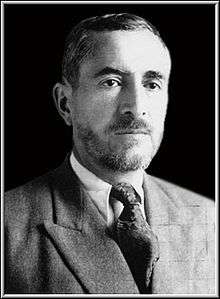Qazi Muhammad
Qazi Muhammad (Persian: قاضی محمد, Kurdish: قازی محەممەد / Qazî Mihemed; 1 May 1893 – 29 March 1947) was an Iranian Kurdish separatist leader who founded the Democratic Party of Iranian Kurdistan and headed the short-lived Soviet-backed Republic of Kurdistan. He was hanged by the Pahlavi dynasty for treason in 1946.[2]
Qazi Muhammad | |
|---|---|
 | |
| President of the Republic of Mahabad | |
| In office 22 January 1946 – 15 December 1946 | |
| Preceded by | Office created |
| Succeeded by | Office abolished |
| Personal details | |
| Born | 1 June 1893 Mahabad, Persia |
| Died | 30 March 1947 (aged 53)[1] Mahabad, Iran |
| Citizenship | Iranian |
| Political party | PDKI |
| Children | Efat and Ali Qazi, Pavin Qazi |
| Profession | Lawyer |
Biography
Qadi Muhammad was born into a noble Kurdish family. After his fathers death, he was nominated as a judge in Mahabad in the 1930s.[3] Qazi Muhammad later became a member of the Komala Zhian I Kurd, a leading Kurdish organization in Iran at the time supported by the Soviets, in April 1945.[4] Soon after he became its leader.[5] Muhammad acted as the President of the Republic of Mahabad, which was founded in January 1946, and declared publicly in March of the same year.[6] He was also the founder of the Kurdish Democratic Party of Iran, that was established after the need for a more transparent party was felt by its adherents. (Komeley Jiyanewey Kurd existed prior to that, as a secret organization.) Mustafa Barzani, one of the leaders of the nationalist Kurdish movement in Iraqi Kurdistan, was also the commander of its army. His cousin Mohammed Hossein Saif Qazi was a minister in his cabinet. A year later, after the Soviets withdrew from Iran, the socialist Kurdish Republic was crushed by Iran's central government.
Family
One of his sons, Ali Qazi, is today an active member in the Kurdish movement. One of his daughters, Efat Ghazi, was killed by a letter bomb in Västerås, Sweden, in 1990.[7] The bomb was addressed to her husband, the Kurdish activist Emir Ghazi.[8] Some analysts speculated that the Iranian government might have been involved in the assassination.[9][10]
See also
- Timeline of Kurdish uprisings
- Abdul Rahman Ghassemlou
- Sadeq Sharafkandi
- Simko
References
| Wikimedia Commons has media related to Qazi Muhammad. |
- McDowall, David (2004). A Modern History of the Kurds (3rd ed.). I.B.Tauris. p. 245. ISBN 9781850434160.
- Portal, Kurdistan (2008-12-20). "Das Vermächtnis des kurdischen Märtyrers Qazi Mohammed". Kurdmania (in German). Archived from the original on 2011-07-27. Retrieved 2009-02-22.
- Jwaideh, Wadie (2006-06-19). The Kurdish National Movement: Its Origins and Development. Syracuse University Press. p. 250. ISBN 978-0-8156-3093-7.
- Jwaideh, Wadie (2006), pp.247–248
- Jwaideh, Wadie (2006-06-19), p. 249
- Jwaideh, Wadie (2006), p. 252
- Fälth, Gun (1990-09-07). "Kvinna sprängd till döds" (in Swedish). Dagens Nyheter.
- Westmar, Bo (1990-09-07). "Bomben var avsedd för maken" (in Swedish). Dagens Nyheter.
- Rahimi, Babak (2002-11-19). "Offer för Irans dödspatruller" (in Swedish). Mana. Retrieved 2007-12-30.
- Darvishpour, Mehrdad (2003-09-30). "Säpo skyddar Irans flyktingspioner". Svenska Dagbladet (in Swedish). Retrieved 2007-12-30.